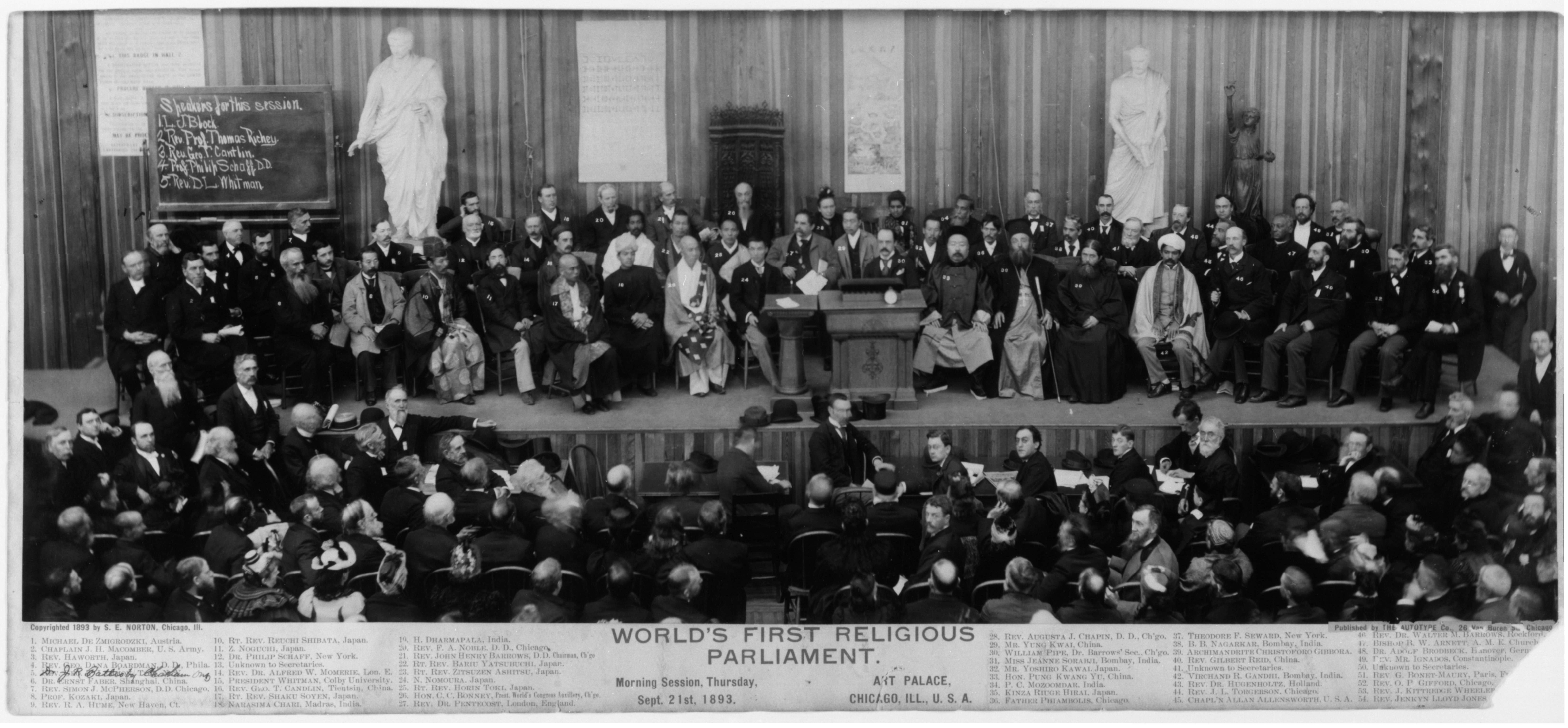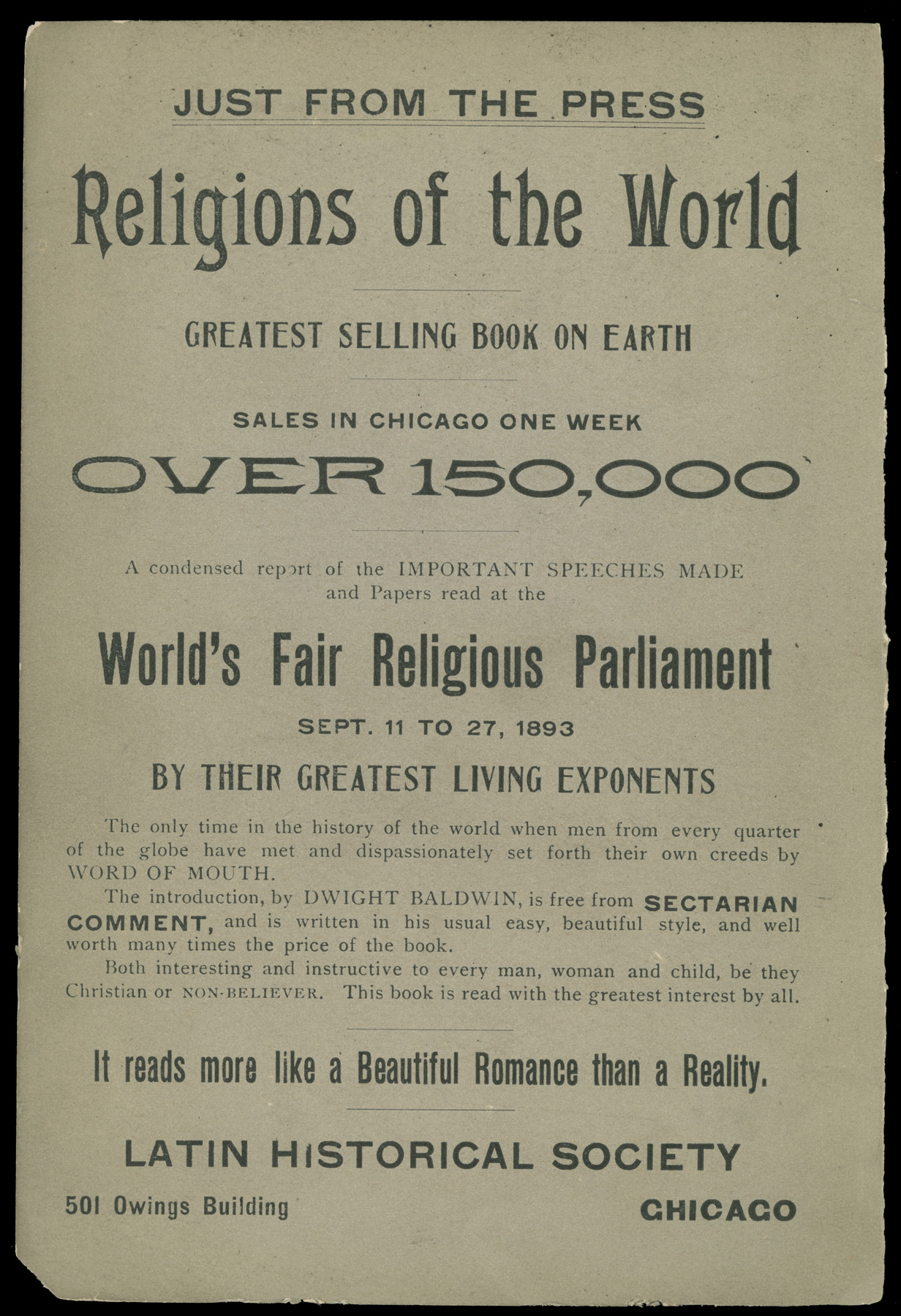The Happenings of the Parliament
Opening Ceremony
The World’s Parliament of Religions commenced with a grand opening ceremony on the morning of September 11th, 1893. Nearly 4,000 spectators arrived, many of them early, to witness the proceedings of this historic day in the Hall of Columbus in the Chicago Art Institute where the Parliament would be housed for the next seventeen days. Before anything else, the newly cast Liberty Bell, made specifically in honor of the Columbian Exposition and bearing the scriptural phrase, “A new commandment I give unto you that ye love one another,” sounded ten times to represent the ten major religions of the world and to honor the delegates who had travelled from far and wide to represent them.
The mass audience sat in silence in anticipation of the delegates’ arrival. A palpable sense of excitement pervaded the room. At the appointed time, the delegates marched down the center aisle of the hall, headed by President Charles Bonney and Cardinal Gibbons. Following them were delegates of all different ethnicities and nationalities, races and creeds, religions and spiritualities. The procession symbolized the Parliament’s aspiration for brotherhood, unity, and the reconciliation of religious differences.
The audience could not help but notice the colorful attire of the Asian delegates, each group having their own distinct style and scheme. The Japanese delegation appeared in fine silk robes that made up the colors of the rainbow. Swami Vivekananda, representing the Hindu faith, was clad in a red robe with a golden turban on his head. Anagarika Dharmapala, a Buddhist representative from Ceylon, wore woolen robes. The Chinese delegation was recorded as wearing simple, traditional Chinese robes, and P.C. Mozoomdar, the most notable representative of the Brahmo-Somaj, perhaps surprised most when he arrived in black clothing that made him resemble a European man.



The audience burst into applause as the delegates had reached the center platform and were seated under their countries’ flags, all of which provided a dynamic background amongst the chaos as they gently waved behind the delegates. After all had settled, everyone, delegates and audience, assembled together in mass prayer with a rendition of the One Hundredth Psalm.
At 10:30 AM, after the universal prayer, President Bonney took the podium and officially called the Parliament to order. After several welcoming addresses by various committee members, all delegates were invited to share a few words. All of them were received with such warmth, and the audience remained in awe of the fact that such a diverse group of religious leaders was in their presence addressing them. Perhaps best remembered are the opening remarks of Swami Vivekananda, who addressed the appreciative audience with, “Brothers and Sisters of America!” which received a thunderous round of applause.
The sentiment of the opening ceremony set the tone for what promised to be an “epoch-making” event for “mutual understanding and appreciation between the world’s religions” as one writer noted in Science magazine. Without even having heard many substantive speeches from the delegates regarding their respective religious beliefs, an article from The Inter-Ocean wrote that these opening festivities, “suggested a unanimity of purpose and an earnestness of desire to sink creed and racial difference and to get back to those common ties of humanity that bind and link men in a world-wide brotherhood.” It is clear that the enthusiasm surrounding the Parliament magnified significantly after this opening day.
Apart from just the sentiment, this ceremony marked the first time Asian religious leaders were given the opportunity to present their religious beliefs to an American public. The fact that Americans were willing to acknowledge the legitimacy of these delegates’ beliefs was a threat to Christian dominance, and as Richard Seager states, “contributed to a growing sense that the old truths of the nineteenth century evangelical worldview were threatening to crumble.” For the most liberal Chirstians, the Parliament was seen as a shining light illuminating the possibility of a more inclusive religious fellowship that was not limited by doctrine or creed. The fact that these delegates, seen as “heathens” to some, walked side by side, hand in hand with their Christian counterparts was arguably a victory in and of itself.

